Diprion pini
Diprion pini, the common pine sawfly, is a sawfly species in the family Diprionidae.[1] It is a serious pest of economic forestry, capable of defoliating large areas of pine forest. It occurs throughout Europe and Russia.
| Diprion pini | |
|---|---|
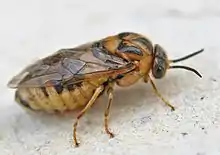 | |
| Female | |
| Scientific classification | |
| Domain: | Eukaryota |
| Kingdom: | Animalia |
| Phylum: | Arthropoda |
| Class: | Insecta |
| Order: | Hymenoptera |
| Suborder: | Symphyta |
| Family: | Diprionidae |
| Genus: | Diprion |
| Species: | D. pini |
| Binomial name | |
| Diprion pini | |
| Synonyms[1][2] | |
| |
Description
Diprion pini is an insect with complete metamorphosis, changing from a caterpillar larva via a pupal stage to a winged adult. Last-stage larvae can be up to 25 millimetres (0.98 in) long; the head is brown, while the body is light green with black spots. The adult (imago) is brown and is around 10 millimetres (0.39 in) long. The larvae feed on pine needles.[3][4]
Eggs are laid in rows in springtime, on pine needles from the previous year. Young caterpillars start feeding on the old needles near where they hatched, leaving the vascular bundles uneaten. Older caterpillars feed more widely, moving to other branches and eating whole needles except for the leaf sheath; late in the season they also consume the current year's needles. The caterpillars live in groups of some 60 to 100 individuals. The pupa is attached to a pine twig.[2]
Distribution and ecology
The species is widely distributed across Europe and Russia, and is present in Algeria, Siberia, and Turkey.[1][2] Its host plants are species of pine including Pinus banksiana (jack pine), P. cembra (arolla pine), P. contorta (lodgepole pine), P. mugo (mountain pine), P. nigra (black pine), P. pinaster (maritime pine), P. radiata (radiata pine), P. strobus (eastern white pine), P. sylvestris (Scots pine), P. uncinata (mountain pine), and P. wallichiana (blue pine).[2]
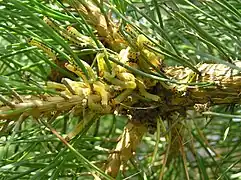 Mass of larvae on pine tree
Mass of larvae on pine tree- Deimatic behaviour: group of larvae waving their heads simultaneously
Pest of forestry
Outbreaks of D. pini are eruptive, rising rapidly to large infestations after long latent periods; this makes monitoring difficult.[2] Scots pines are not generally killed by a single defoliation, but weakened trees may suffer increased attack by bark beetles, buprestid beetles, and pine weevils, which can kill trees, as can repeated defoliation. During high rates of defoliation, the growth rate of pines decreases significantly.[2] Climate change appears to be allowing the pest to damage forests increasingly far north, such as in Scandinavia. Since it feeds until late in the autumn, affected trees are weakened and often die in the subsequent winter.[5] The presence of D. pini can be monitored with pheromone traps.[6] Serious infestations are treated by aerial spraying with insecticides such as diflubenzuron or pyrethroids.[2] Biological control with the parasitoid of sawfly pupae Dahlbominus fuscipennis has been used effectively.[2] The planting of mixtures of species of tree has been proposed to reduce pest damage.[2][7]
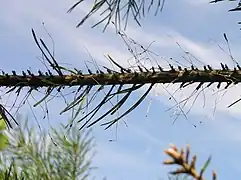 Larval damage to pine
Larval damage to pine.jpg.webp) Pine sawfly pupa killed by sawfly parasitoid wasp, Dahlbominus fuscipennis, with adult wasps
Pine sawfly pupa killed by sawfly parasitoid wasp, Dahlbominus fuscipennis, with adult wasps
See also
- Neodiprion sertifer, another common European pine sawfly pest, also called red pine sawfly and fox-coloured sawfly
References
- "Diprion pini (Linnaeus, 1758)". Fauna Europaea. Fauna Europaea Secretariat, Museum für Naturkunde, Berlin. Retrieved 27 June 2022.
- "Diprion pini (common pine sawfly)". PlantwisePlus Knowledge Bank. 10 December 2020. Retrieved 6 September 2023.
- "Pine sawflies". Royal Horticultural Society. Retrieved 6 September 2023.
- Diprion pini (common pine sawfly), CABI Publishing, 2022-01-07, doi:10.1079/cabicompendium.19194
- Krokene, Paal (6 December 2014). "The common pine sawfly – a troublesome relative". Science Nordic. Archived from the original on 29 November 2016. Retrieved 28 November 2016.
- Anderbrant, O. "Monitoring pine sawflies with pheromone traps." Methodology of forest insect and disease survey in Central Europe. Proceedings, First Workshop of the IUFRO WP 7.03. 10, Ustroń-Jaszowiec, Poland, 21–24 April 1998. Instytut Badawczy Leśnictwa (Forest Research Institute), 1998.
- Herz, Annette, 1997. Zur Effektivität und Struktur der Parasitoidengemeinschaft von Diprion pini (L.) (Hym.: Diprionidae) bei latenten Dichten des Wirtes. PhD thesis. Ludwig Maximilians University, Munich.
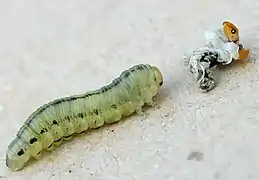
.jpg.webp)
.jpg.webp)
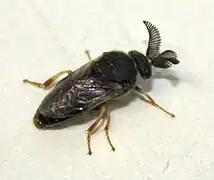
.jpg.webp)